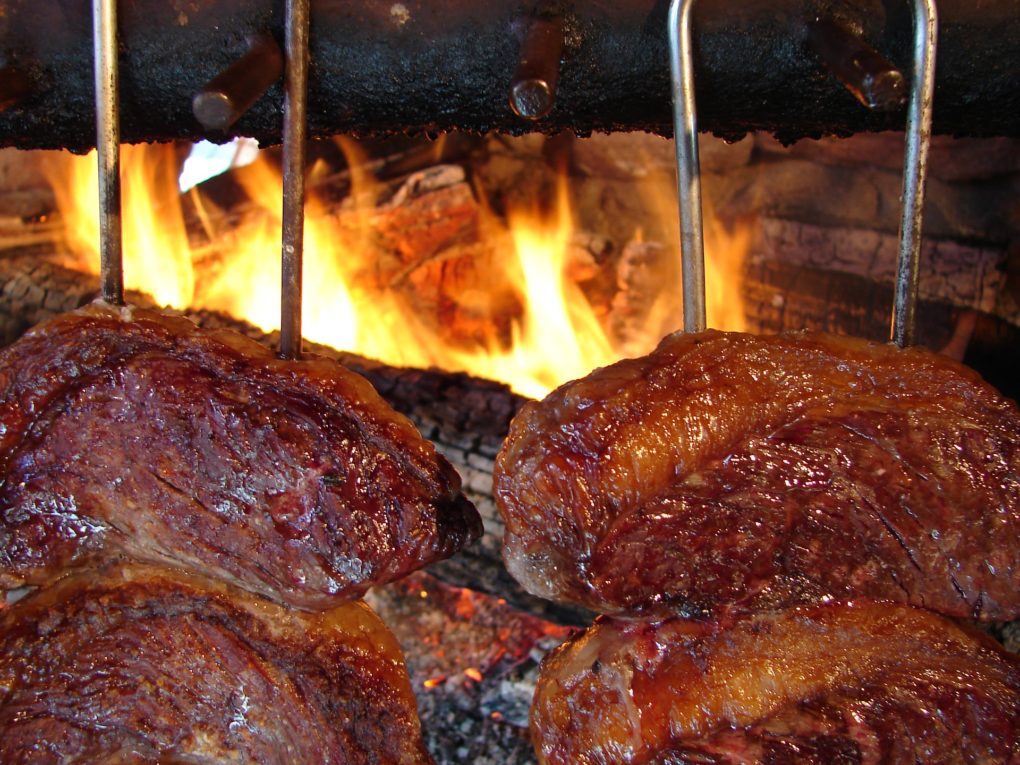If you’re something of a fan of barbecued meats, and you love Brazilian cuisine, you’re going to love picanha (pee-kahn-ya).
But what is picanha? It’s a particular cut of beef that’s also known as ‘sirloin cap’ or ‘rump cap,’ and it is one of the top meat cuts served at Brazilian churrascarias, or Brazilian barbecue restaurants.
How It’s Cooked
The first thing you need to know is that unlike in countries such as the US, where the fat is cut off before it’s cooked, picanha is cooked with the fat still on the meat.
The most common method of cooking picanha is as follows:
- The two halves of the rump cap (with about a centimeter and a half of fat still on the meat) are cut into three big slices against the grain, and folded and placed onto giant metal skewers. If the picanha halves you get are large, which they usually are, you might be able to get four slices out of the meat, but the rule of thumb tends to be three slices at once. If you don’t happen to have big metal skewers, that’s fine. You can simply place the meat on your regular grill.
- Next, rock (kosher) salt is generously sprinkled over the skewered meat, but you don’t want to salt the fat. Just salt the actual meat portion. The fat has its own flavours to lend to the meat as it cooks. Also, keep in mind that while other barbecue traditions use a lot of marinades and sauces, Brazilian churriscarias are not known for placing marinades and seasonings on the meat prior to cooking, as Brazilian cuisine tends to favour cherishing the meat’s own flavour, rather than ‘disguising’ it. If you wish to be authentic in cooking picanha for the first time, use only the salt, as that, mixed with the fat, will be more than enough flavour. Once you taste it this way, you might not go back to adding all the sauces and seasonings you might otherwise be accustomed to.
- Once the salt is on the picanha, it’s time for grilling. Traditionally, the meat is cooked, rodizio style, that is, on a spit, and it’s slow-roasted, usually, for about 30 minutes till the outside is browned, and the middle is rare, or medium-rare. Then it’s taken to the table and sliced off onto your plate directly from the skewer. This said, if you’re in a churrascuria, you can still get your picanha cooked to order, which includes well-done, if you’re a bit skittish about eating any meat that’s on the rare side.
Otherwise, the first ends are cut off, and the meat is resalted and placed back onto the rotizia for further cooking, so each person can get a truly flavourful end cut.
Alternate Grill Method
If you don’t have a rotizia in your backyard (most don’t), then here is a way to grill your picanha that’s commonly used by many Brazilians as well as folks from Uruguay and Argentina:
- Cut your meat into strips about 3.5 centimeters wide, and set up the grill for ‘direct grilling’ and heat up on ‘high.’ Then, brush and oil the grate.
- Next, arrange the meat, fat-side down, and grill till the fat is halfway rendered and crispy brown. This usually takes about 2-4 minutes, and you’ll want to move the meat frequently to avoid flare-ups from the fat dripping into the fire. Arrange the meat so the strips are lying on their sides, for about 2 minutes. Do the same with the bottom part of the meat.
You’re looking for a medium-rare temperature, which is about 62 degrees Celsius, though you could cook it a bit longer in case you or other people prefer it closer to well done. But traditionally, medium-rare is the way it’s usually served.
Once the meat is finished, place the meat onto a clean cutting board and slice thin across the grain, including both fat and meat on each piece. If you like, you can serve it with a traditional Brazilian salsa, such as molho a campanha which, unlike Mexican-style salsas, contains no hot peppers or cilantro.
As you can see, picanha is truly the most popular meat cut in Brazil, and once you try it, you’ll ask for it over and over. Just keep the slices thin so you can get up from the table more comfortably.




